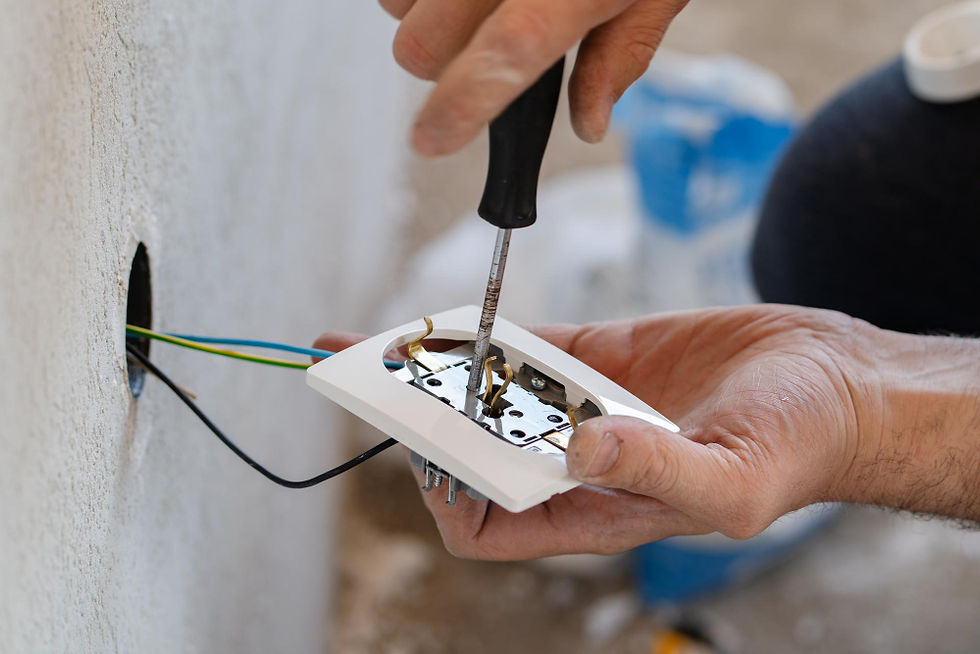Safety Tips to Follow Before Installing Electrical Wiring for Light Switches
- 24emergencyelectri
- Sep 4
- 3 min read
Electricity powers modern homes. But working on electrical wiring for light switches introduces real risks for injury and fire when not adhering to proper safety regulations.
Even routine tasks like replacing a light switch come with shock, burns, and accidental arcing, underscoring why careful preparation and discipline are essential before any installation. By understanding the dangers and taking practical steps, anyone can ensure that electrical wiring for light switches is completed safely and efficiently.

Why Safety Matters?
Every year, improper handling of electrical wiring for light switches leads to thousands of household fires and electrical shocks. The correct safety measures can save lives and reduce property damage. Whether tackling a DIY project or hiring a professional, knowledge and execution of safety principles remain vital.
1. Always Turn Off Power
Never begin any work on electrical wiring for light switches without first switching off the power at the main circuit breaker or fuse box. Use a voltage tester to confirm that there is no live current flowing to the area where you'll work. Tape the breaker in the "off" position and inform everyone in the household that electrical work is in progress to avoid accidental reactivation.
2. Gather Proper Tools and Equipment
Use only insulated tools and wear non-conductive gloves, protective clothing, and rubber-soled shoes. Choose a bamboo, wooden, or fibreglass ladder if working at height—metal ladders pose electrocution risks. Essential tools for light switch wiring include:
Voltage tester
Wire cutters/strippers
Needle-nose pliers
Electrical tape
Wire nuts
3. Plan Your Wiring Layout
Before touching any wires, understand and plan the wiring layout. Review related diagrams for the specific switch type—single pole, three-way, or dimmers. Plan what outlets, switches, and fixtures will be involved, and don't improvise wiring routes to avoid code violations and safety hazards.
4. Use High-Quality Wires and Components
Inferior wires and switches can overheat, melt insulation, and spark fires. Only use certified wires and devices that meet safety standards. Check switchgear and components for signs of damage, and replace defective items.
5. Childproof and Isolate Your Work Area
If children are present, ensure outlets and switches are inaccessible while the work is in progress—use outlet covers and barriers. Keep pets and unrelated household items away from your workspace to prevent interference or accidents.
6. Inspect and Test Before Starting
Check wires, outlets, switches, and surrounding metal covers with an electrical tester to ensure they are not energised. Check cables for damage, wear, or deteriorating insulation. Replace any questionable wires; never rely on temporary fixes like electrical tape unless it's a real emergency.
7. Avoid Water, Gas Pipes, and Metal Surfaces
Water and electricity are a deadly combination. Ensure the work area is completely dry and free from spills or puddles. Never touch plumbing or gas pipes while handling electrical wiring for light switches—they serve as grounding and could result in severe shock if contacted during work.
8. Confirm Connections and Terminal Safety
Connect wires securely. Loose connections or exposed bare wires can cause electrical shorts and fires. Use wire nuts and electrical tape to insulate every connection, and ensure no bare wire is exposed after installation.
9. Respect Electrical Codes and Local Regulations
Do not perform wiring jobs that violate local codes. Installations involving electrical wiring for light switches need review by a certified electrician for compliance. If unsure, always consult a professional electrician.
10. Test the Installation Before Use
After installing, turn the power back on and test the switches using a voltage tester. Confirm the switch is regulating the intended fixture, and check for smooth operation without sparks, flickering, or excessive heat.
Common Mistakes to Avoid
Failing to turn off the power before working—this remains the primary reason for electrical accidents.
Using damaged or uncertified wires can lead to short circuits.
Rushing installation: never hurry when securing wire connections or mounting the switch.
Neglecting safety gear, such as gloves and insulated tools, is a serious safety concern.
When to Call a Professional
If the project feels overwhelming or involves complex rewiring panels, handling many circuits, or dealing with water-prone areas (bathroom switches, outdoor installations), always contact a certified electrician. Professional electrical contractors ensure the electrical wiring for light switches is both safe and code-compliant.
Conclusion
Safety is paramount when working with electrical wiring for light switches. Always shut off power, use the correct tools, plan carefully, and prioritise high-quality components. Follow these ten tips to keep homes safe and prevent electrical hazards. Where doubt exists, consult a professional electrician from 24emergency Electrician Ltd to ensure all work meets safety standards and regulations.




Comments